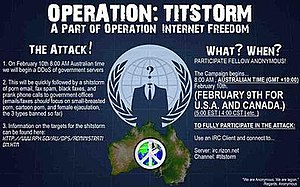| Operation Titstorm | |||
|---|---|---|---|
 A flyer for Operation Titstorm | |||
| Date | February 2010 | ||
| Location | Internet and Australia | ||
| Methods | spam, street protests, denial-of-service attacks | ||
| Resulted in | Proposed laws failed to go through | ||
| Parties | |||
The February 2010 Australian cyberattacks were a series of denial-of-service attacks conducted by the Anonymous online community against the Australian government in response to proposed web censorship regulations.[1] Operation Titstorm was the name given to the cyber attacks by the perpetrators. They resulted in lapses of access to government websites on 10 and 11 February 2010. This was accompanied by emails, faxes, and phone calls harassing government offices. The actual size of the attack and number of perpetrators involved is unknown but it was estimated that the number of systems involved ranged from the hundreds to the thousands. The amount of traffic caused disruption on multiple government websites.
Australian Telecommunications Minister Stephen Conroy proposed the regulations that would mainly filter sites with pornographic content. Various groups advocating uncensored access to the Internet, along with companies like Google and Yahoo!, object to the proposed filter. A spokesperson for Conroy said that the actions were not a legitimate form of protest and called it irresponsible. The attacks also drew criticism from other filter protest groups. The initial stage was followed by small in-person protests on 20 February that were called "Project Freeweb".